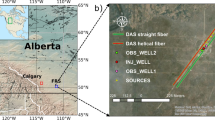Abstract
It is very important for converting the seismic data from the time domain to the depth domain. Here we discuss the approaches of inverse modeling of travel times for determination of the P-wave velocity (Vp). The migration section of the single channel seismic data is used to define the model horizons and help to control their geometry. Wide angle hydrophone data of OBS are used to determine P-wave travel times. The picked travel times from various shots are inverted for P-wave interval velocities using RayInvr, which calculated theoretical travel times via ray tracing. Damped least squares optimization is performed to fine tune the fits between observed and calculated travel times. In the end, the Vp curve is achieved and the results are compared with that derived from the conventional hyperbolic curve velocity analysis method, the shape of the two curves are similar, and the velocity increases in the layer where gas hydrates are present.







Similar content being viewed by others
References
Aki K, Richards PG (1980) Quantitative seismology: theory and methods, vol 1. WH Freeman and Co, San Francisco
Cerveny V, Molotkov IA, Psencik I (1977) Ray method in seismology. University Karlova, Prague
Chen D, Huang Y, Yuan X, Cathles LM (2005) Seep carbonates and preserved methane oxidizing archaea and sulfate reducing bacteria fossils suggest recent gas venting on the seafloor in the Northeastern South China Sea. Mar Pet Geol 22:613–621
Han X, Suess E, Huang Y, Wu N, Bohrmann G, Su X, Eisenhauer A, Rehder G, Fang Y (2008) Jiulong methane reef: microbial mediation of seep carbonates in the South China Sea. Mar Geol 249:243–256
Jose T, Minshull T, Westbrook G, Nouzé H, Ker S, Gailler A, Exley R, Berndt C (2008) A geophysical study of a pockmark in the Nyegga region, Norwegian Sea. In: Proceedings of the 6th international conference on gas hydrates
Karastathis VK, Papamarinopoulos S, Jones RE (2001) 2-D velocity structure of the buried ancient canal of Xerxes: an application of seismic methods in archaeology. J Appl Geophys 47:29–43
Karastathis VK, Louis JF, Arvanitis M, Karmis P (2002) Application of inverse ray-tracing seismic modelling techniques in the Ikaria airport site. J Balk Geophys Soc 5:107–114
Lutter WJ, Nowack RL (1990) Inversion for crustal structure using reflections from the PASSCAL Ouachita experiment. J Geophys Res 95:4633–4646
Ogunsuyi O, Schmitt D, Ahmad J, Jason F (2009) Seismic traveltime inversion to complement reflection profile in imaging a glacially buried valley. SEG Houston 2009 International Exposition and Annual Meeting, pp 3675–3679
Parsiegla N, Stankiewicz J, Gohl K, Ryberg T, Uenzelmann-Neben G (2009) Southern African continental margin: dynamic processes of a transform margin. Geochem Geophys Geosyst 10(3):1–20
Pim J, Peirce C, Watts AB, Grevemeyer I, Krabbenhoeft A (2008) Crustal structure and origin of the Cape Verde Rise. Earth Planet Sci Lett 272:422–428
Song JL, ten Brink U (2004) RayGUI 2.0—A graphical user interface for interactive forward and inversion ray-tracing. US Geol Surv Open-File Rep, 2004–1426
Wang T, Yang B, Deng J, Lee C, Liu C (2010) Seismic imaging of gas hydrates in the northernmost South China sea. Mar Geophys Res 31:59–76
Wang X, Xia C, Liu X (2012a) A case study: imaging OBS multiples of South China Sea. Mar Geophys Res 33:89–95. doi:10.1007/s11001-012-9148-2
Wang X, Xia C, Minshull TA (2012b) Extrapolating the OBS data using the Kirchhoff integral Method. Geoscience 26(6):1231–1236
Wu S, Zhang G, Huang Y, Liang J, Wong HK (2005) Gas hydrate occurrence on the continental slope of the northern South China Sea. Mar Pet Geol 22:403–412
Wu S, Wang X, Wong HK, Zhang G (2007) Low-amplitude BSRs and gas hydrate concentration on the northern margin of the South China Sea. Mar Geophys Res 28:127–138
Zelt CA, Smith RB (1992) Seismic traveltime inversion for 2-D crustal velocity structure. Geophys J Int 108:16–34
Zhao M, Qiu X, Xia S, Xu H, Wang P, Wang TK, Lee CS, Xia K (2010) Seismic structure in the northeastern South China Sea: S-wave velocity and Vp/Vs ratios derived from three-component OBS data. Tectonophysics 480:183–197
Acknowledgments
This research is funded by the Fundamental Research Funds for the Central Universities of China, National Basic Research Program of China (973 Program, 2009CB219505) and International Science & Technology Cooperation Program of China (Grant No. 2010DFA21630).
Author information
Authors and Affiliations
Corresponding author
Additional information
An erratum to this article is available at http://dx.doi.org/10.1007/s11001-015-9259-7.
Rights and permissions
About this article
Cite this article
Wang, X., Minshull, T.A., Xia, C. et al. A case study: travel time inversion for P-wave velocity using OBS data of South China Sea. Mar Geophys Res 33, 389–396 (2012). https://doi.org/10.1007/s11001-013-9167-7
Received:
Accepted:
Published:
Issue Date:
DOI: https://doi.org/10.1007/s11001-013-9167-7




